Sustainability Data
Performance Summary (Social)
The scope of calculation for social data is the Tokyo Electron Group (26 consolidated companies), and the calculating period is fiscal year 2025 (April 1, 2024 to March 31, 2025).
- Japan: Tokyo Electron Ltd., Tokyo Electron Technology Solutions Ltd., Tokyo Electron Kyushu Ltd., Tokyo Electron Miyagi Ltd., Tokyo Electron FE Ltd. and Tokyo Electron BP Ltd.
- Overseas: 20 consolidated subsidiaries (including Tokyo Electron America, Inc., Tokyo Electron Europe Ltd., Tokyo Electron Korea Ltd., Tokyo Electron Taiwan Ltd., Tokyo Electron (Shanghai) Ltd. and Tokyo Electron Singapore Pte. Ltd.)
●denotes data with third-party assurance in the Tokyo Electron Sustainability 2025
Composition of Employees(Entire Group)
| FY2021 | FY2022 | FY2023 | FY2024 | FY2025 | ||
|---|---|---|---|---|---|---|
| Regular employees (Region) |
Number of regular employees | 14,022 | 15,140 | 16,605 | 17,071 | 18,893 |
| Japan | 7,921 | 8,234 | 8,796 | 9,150 | 9,847 | |
| Rest of Asia | 3,796 | 4,328 | 4,819 | 4,854 | 5,640 | |
| Europe and Middle East | 509 | 578 | 669 | 708 | 739 | |
| North America | 1,796 | 2,000 | 2,321 | 2,359 | 2,667 | |
Composition of Employees (Japan)
| FY2021 | FY2022 | FY2023 | FY2024 | FY2025 | ||
|---|---|---|---|---|---|---|
| Employees (Employment type) |
Number of employees | 8,296 | 8,661 | 9,325 | 9,746 | 10,488 |
| Regular employees | 7,921 | 8,234 | 8,796 | 9,150 | 9,847 | |
| Men | 6,722 | 6,944 | 7,429 | 7,716 | 8,279 | |
| Women | 1,199 | 1,290 | 1,367 | 1,434 | 1,568 | |
| Non-regular employees | 375 | 427 | 529 | 596 | 641 | |
| Men | 348 | 403 | 490 | 553 | 591 | |
| Women | 27 | 24 | 39 | 43 | 50 | |
Recruitment/Employment(Japan)
| FY2021 | FY2022 | FY2023 | FY2024 | FY2025 | ||
|---|---|---|---|---|---|---|
| New graduates hired | Number hired | 253 | 209 | 231 | 353 | 404 |
| Under 30 yrs. old | 252 | 208 | 231 | 351 | 403 | |
| Men | 207 | 177 | 193 | 304 | 320 | |
| Women | 45 | 31 | 38 | 47 | 83 | |
| 30–49 yrs. old | 1 | 1 | 0 | 2 | 1 | |
| Men | 1 | 0 | 0 | 2 | 1 | |
| Women | 0 | 1 | 0 | 0 | 0 | |
| 50 yrs. old and over | 0 | 0 | 0 | 0 | 0 | |
| Men | 0 | 0 | 0 | 0 | 0 | |
| Women | 0 | 0 | 0 | 0 | 0 | |
| Percentage of women | 17.8 | 15.3 | 16.5 | 13.3 | 20.5 | |
| Career-track recruits | Number hired | 191 | 400 | 580 | 271 | 627 |
| Under 30 yrs. old | 56 | 131 | 209 | 89 | 193 | |
| Men | 49 | 96 | 185 | 72 | 159 | |
| Women | 7 | 35 | 24 | 17 | 34 | |
| 30–49 yrs. old | 123 | 250 | 355 | 172 | 409 | |
| Men | 92 | 202 | 306 | 141 | 339 | |
| Women | 31 | 48 | 49 | 31 | 70 | |
| 50 yrs. old and over | 12 | 19 | 16 | 10 | 25 | |
| Men | 11 | 17 | 13 | 8 | 23 | |
| Women | 1 | 2 | 3 | 2 | 2 | |
| Percentage of women | 20.4 | 21.3 | 13.1 | 18.5 | 16.9 | |
| Employees with disabilities | Percentage hired (TEL) | 2.43 | 2.32 | 2.03 | 2.18 | 2.44 |
| Percentage hired (Group in Japan) |
2.30 | 2.37 | 2.27 | 2.34 | 2.46 | |
| Reemployment system | Number of users | 313 | 389 | 475 | 545 | 586 |
| Men | 305 | 376 | 451 | 510 | 545 | |
| Women | 8 | 13 | 24 | 35 | 41 | |
| Percentage of regular employees who received regular performance and career evaluations | 100.0 | 100.0 | 100.0 | 100.0 | 100.0 | |
Female managers (Entire Group)
| FY2021 | FY2022 | FY2023 | FY2024 | FY2025 | ||
|---|---|---|---|---|---|---|
| Female Managers*¹*² | Number of people | — | 163 | 182 | 221 | 253 |
| Percentage | — | 5.5 | 5.7 | 6.3 | 6.4 | |
| Number of people (senior directors and above*³) |
— | 10 | 16 | 20 | 21 | |
| Percentage (senior directors and above*³) |
— | 2.2 | 3.3 | 3.7 | 3.5 | |
Percentage of female managers, calculation method: (Number of female managers/Number of managers) × 100 (The number of managers includes experts (from fiscal year 2022) and employees reemployed after retirement (from fiscal year 2024). )
As of March 31
Employees of a certain level or position based on the global human resources system
Female managers (Japan)
| FY2021 | FY2022 | FY2023 | FY2024 | FY2025 | ||
|---|---|---|---|---|---|---|
| Female managers*¹*² | Number of people | 26 | 46 | 51 | 67 | 77 |
| Percentage | 2.2 | 2.6 | 2.7 | 3.1 | ●3.3 | |
Percentage of female managers, calculation method: (Number of female managers/Number of managers) × 100 (The number of managers includes experts (from fiscal year 2022) and employees reemployed after retirement (from fiscal year 2024). )
As of March 31
Employee retention (Japan)
| FY2021 | FY2022 | FY2023 | FY2024 | FY2025 | ||
|---|---|---|---|---|---|---|
| Employee retention |
Retention after three years of joining TEL* | 94.1 | 94.7 | 92.7 | 93.1 | 94.6 |
| Men | 94.8 | 95.0 | 93.2 | 93.6 | 95.0 | |
| Women | 89.3 | 93.5 | 90.6 | 90.9 | 92.1 | |
| Average service years | 17 yrs. 4 mos. | 17 yrs. 2 mos. | 16 yrs. 8 mos. | 16 yrs. 6 mos. | 15 yrs. 10 mos. | |
| Men | 17 yrs. 7 mos. | 17 yrs. 6 mos. | 16 yrs. 10 mos. | 16 yrs. 8 mos. | 16 yrs. 0 mos. | |
| Women | 15 yrs. 10 mos. | 15 yrs. 8 mos. | 15 yrs. 7 mos. | 15 yrs. 7 mos. | 14 yrs. 11 mos. | |
Average in recent five years
Employee turnover (Entire Group)
| FY2021 | FY2022 | FY2023 | FY2024 | FY2025 | ||
|---|---|---|---|---|---|---|
| Turnover*¹ | Employee turnover | — | 589 | 599 | 415 | 421*² |
| Men | — | 507 | 509 | 351 | 347 | |
| Women | — | 82 | 90 | 64 | 83 | |
| Turnover percentage | — | 4.2 | 3.9 | 2.5 | 2.4 | |
Turnover due to personal circumstances
Including those who did not declare their gender
Employee Turnover (Japan)
| FY2021 | FY2022 | FY2023 | FY2024 | FY2025 | ||
|---|---|---|---|---|---|---|
| Turnover * | Employee turnover | 87 | 87 | 98 | 113 | 95 |
| Men | 75 | 69 | 81 | 93 | 76 | |
| Women | 12 | 18 | 17 | 20 | 19 | |
| Turnover percentage | 1.0 | 1.0 | 1.1 | 1.2 | 0.9 | |
Turnover due to personal circumstances
Work-life Balance (Japan)
| FY2021 | FY2022 | FY2023 | FY2024 | FY2025 | ||
|---|---|---|---|---|---|---|
| Annual paid leave | Take-up rate*¹ | 62.5 | 64.6 | 70.0 | 80.6 | ●78.9 |
| Refreshment leave | Number of those who took leave | 688 | 512 | 1,731 | 630 | 819 |
| Men | 610 | 435 | 1,485 | 547 | 697 | |
| Women | 78 | 77 | 246 | 83 | 122 | |
| Paternity leave | Number of those who took leave | 148 | 137 | 149 | 169 | 161 |
| Childcare leave | Number of those who took leave | 41 | 70 | 96 | 153 | 213 |
| Men | 16 | 36 | 57 | 122 | 167 | |
| Women (percentage who took leave) |
25 (92.6) |
34 (97.1) |
39 (97.5) |
31 (100) |
46 (97.9) |
|
| Number of those who returned to work after leave | 54 | 60 | 76 | 155 | 173 | |
| Men | 15 | 32 | 43 | 120 | 150 | |
| Women | 39 | 28 | 33 | 35 | 23 | |
| Percentage reinstated | 96.4 | 95.2 | 98.7 | 100.0 | 99.4 | |
| Retention rate | 95.0 | 90.0 | 97.9 | 91.2 | 96.7 | |
| Shorter working hour system |
Number of those who used | 132 | 110 | 105 | 103 | 90 |
| Men | 9 | 7 | 10 | 10 | 14 | |
| Women | 123 | 103 | 95 | 93 | 76 | |
| Leave to care for a sick /injured child | Number of those who took leave | 510 | 547 | 599 | 661 | 695 |
| Men | 353 | 373 | 424 | 513 | 555 | |
| Women | 157 | 174 | 175 | 148 | 140 | |
| Childcare support leave | Number of those who took leave | 86 | 80 | 98 | 113 | 121 |
| Men | 29 | 23 | 33 | 45 | 77 | |
| Women | 57 | 57 | 65 | 68 | 44 | |
| Extended nursing care leave | Number of those who took leave | 2 | 1 | 4 | 6 | 3 |
| Men | 0 | 0 | 4 | 5 | 2 | |
| Women | 2 | 1 | 0 | 1 | 1 | |
| Short nursing care leave | Number of those who took leave | 110 | 87 | 85 | 100 | 134 |
| Men | 69 | 57 | 53 | 54 | 81 | |
| Women | 41 | 30 | 32 | 46 | 53 | |
| Shorter working hour system for nursing care |
Number of those who used | 0 | 4 | 0 | 1 | 2 |
| Men | 0 | 2 | 0 | 1 | 2 | |
| Women | 0 | 2 | 0 | 0 | 0 | |
| Spousal transfer leave system | Number of those who used | — | — | — | 3 | 7 |
Take-up rate of annual paid leave calculation method: (Days of paid leave taken by employees*²) / (Days of paid leave provided to employees*²) × 100
Incl. non-regular employees
Products/Innovation
| FY2021 | FY2022 | FY2023 | FY2024 | FY2025 | ||
|---|---|---|---|---|---|---|
| Total number of incidents of non-compliance with regulations and voluntary codes concerning the health and safety impacts of products and services | 0 | 0 | 0 | 0 | 0 | |
| Active issued patents*¹ (Region/Country) | Number of active issued patents | 18,692 | 19,572 | 21,645 | 23,249 | 24,996 |
| Japan | 5,484 | 5,703 | 6,307 | 6,715 | 7,069 | |
| U.S. | 4,822 | 4,988 | 5,360 | 5,603 | 5,803 | |
| Europe | 206 | 167 | ー*² | ー*² | ー*² | |
| Korea | 3,363 | 3,731 | 4,683 | 5,111 | 5,717 | |
| Taiwan | 2,925 | 3,014 | 3,120 | 3,326 | 3,541 | |
| China | 1,892 | 1,969 | 2,175 | 2,494 | 2,866 | |
Figures for fiscal year 2021 to fiscal year 2022 are based on our database; figures for fiscal year 2023 onwards are based on LexisNexis®PatentSight® database.
Europe is not included in the scope.
| 2019.12 | 2020.12 | 2021.12 | 2022.12 | 2023.12 | ||
|---|---|---|---|---|---|---|
| Global patent application rate*¹ | 74.3 | 74.6 | 80.1*² | 79.9*² | 77.3*² | |
Percentage applied for in countries other than Japan of the number of inventions leading to patents in each calendar year.
Added international applications filed under the Patent Cooperation Treaty (PCT) to applications filed in other countries.
| 2020.12 | 2021.12 | 2022.12 | 2023.12 | 2024.12 | ||
|---|---|---|---|---|---|---|
Patent application success rate* |
Japan | 84.9 | 79.8 | 74.5 | 81.8 | 77.9 |
| U.S. | 87.3 | 83.9 | 81.5 | 80.7 | 86.1 |
Percentage of patent applications that have been allowed among those that have completed examination each calendar year.
Customer
| FY2021 | FY2022 | FY2023 | FY2024 | FY2025 | |
|---|---|---|---|---|---|
| Percentage of respondents who selected "Very Satisfied" or "Satisfied" in the customer satisfaction survey | 96.7 | 100.0 | 100.0 | 100.0 | 100.0 |
Safety
| FY2021 | FY2022 | FY2023 | FY2024 | FY2025 | |
|---|---|---|---|---|---|
| Percentage of employees who received "Safety Foundation Training" | 100 | 100 | 100 | 100 | 100 |
| Percentage of employees who received training "Safety Technical Training" | 100 | 100 | 100 | 100 | 100 |
| Lost time incident rate (LTIR) | 0.63 | 0.66 | 0.83 | 0.31 | 0.32 |
| Number of workplace injuries per 200,000 work hours (TCIR) | 0.27 | 0.30 | 0.33 | 0.15 | 0.23 |
Procurement
| FY2021 | FY2022 | FY2023 | FY2024 | FY2025 | |
|---|---|---|---|---|---|
| Percentage of new important suppliers screened using social criteria | 100 | 100 | 100 | 100 | 100 |
| Rate of improvement after supply chain sustainability assessment | 23.1 | 31.5 | 30.5 | 29.2 | ー*¹ |
| Rate of improvement after supply chain BCP assessment | 20.3 | 24.4 | 22.2 | 20.4 | 19.3 |
| Number of identified RMAP conformant smelters (rate of identification) |
236(100) | 243(100) | 234(100) | 238(100) | 298(99)*² |
Comparison not possible due to revision of questionnaire
Cobalt added to the 3TG (tantalum, tin, tungsten and gold) target minerals from the fiscal year 2025 survey
Governance
| FY2021 | FY2022 | FY2023 | FY2024 | FY2025 | |
|---|---|---|---|---|---|
| Total number of critical incidents notified to the Board of Directors | 0 | 0 | 0 | 0 | 0 |
| Total number of incidents subject to legal action on the basis of anti-competitive conduct, anti-trust activity, or monopolistic practices where the governance body’s involvement was revealed | 0 | 0 | 0 | 0 | 0 |
| Number of executive officers who received training on anti-corruption*¹ | 15 | 20 | 28 | 0 | 26 |
| Total number (percentage) of directors who provided instructions on the body’s policies and procedures in relation to anti-corruption*¹ | 11(100) | 12(100) | 6(100) | 6(100) | 7(100) |
| Total number (percentage) of directors who received training on anti-corruption*¹ | 0(0) | 0(0) | 3(50) | 0(0) | 3(42.8) |
| Payment to industry groups, etc. (thousand yen)*² | 32,036 | 56,374 | 73,313 | 82,263 | 86,099 |
| Payment to political affiliated organizations (yen) | 0 | 0 | 0 | 0 | 0 |
| Average tenure of directors | 6.09 | 6.58 | 5.16 | 6.16 | 5.57 |
| Average rate of attendance for Board meetings | 98.96 | 99.50 | 98.62 | 99.09 | 99.15 |
Scope: Japan
Industry groups were reviewed from fiscal year 2022 (Target: Global).
Compliance
| FY2021 | FY2022 | FY2023 | FY2024 | FY2025 | ||
|---|---|---|---|---|---|---|
| Education on TEL’s Code of Ethics/pledge rate*¹ | 98.8 | 91.6 | 96.1 | 94.9*² | 96.7 | |
| Percentage of employees who have consented to the information security agreement | 99.4 | 99.9 | 100.0 | 99.3 | 100.0 | |
| Significant fines and non-monetary sanctions for non-compliance with laws and regulations in the social and economic area |
0 | 0 | 0 | 0 | 0 | |
| Number of cases that lead to disciplinary action due to compliance infractions*1*3 | ー | ー | ー | 59 | 43 | |
| Bribery/Corruption | ー | ー | ー | 0 | 0 | |
| Competition Act/Anti-Monopoly Act | ー | ー | ー | 0 | 0 | |
| Money laundering/Insider trading | ー | ー | ー | 0 | 0 | |
| Information security/Intellectual property | ー | ー | ー | 3 | 1 | |
| Personal information | ー | ー | ー | ー | 0 | |
| Conflicts of interest | ー | ー | ー | 0 | 0 | |
| Harassment | ー | ー | ー | 22 | 12 | |
| Other (Violations of service obligations) | ー | ー | ー | 34 | 30 | |
Scope: Entire Group
Period is from March to May 2024.
Includes violations of the Tokyo Electron Group Code of Ethics, company regulations, etc.
Social Contribution
| FY2021 | FY2022 | FY2023 | FY2024 | FY2025 | ||
|---|---|---|---|---|---|---|
| Spending on social contribution (million yen)*¹ | 244 | 170 | 301 | 533 | 601 | |
| Cash donations breakdown | Charity donations (providing donations/relief supplies to charity organizations) |
13 | 15 | 9 | 7 | 9 |
| Community investment (charitable expenses for long-term cause for community) |
62 | 75 | 40 | 33*² | 35 | |
| Commercial initiatives (charitable expenses with anticipated effects on business growth) |
25 | 10 | 51 | 61*² | 56 | |
Spending on social contribution activities excluding disaster relief contributions
Review of cash donations breakdown implemented in the fiscal year 2025
Performance Summary (Environment)
The scope of calculation for environmental data is the Tokyo Electron Group (26 consolidated companies), and the calculating period is fiscal year 2025 (April 1, 2024 to March 31, 2025).
- Japan: Tokyo Electron Ltd., Tokyo Electron Technology Solutions Ltd., Tokyo Electron Kyushu Ltd., Tokyo Electron Miyagi Ltd., Tokyo Electron FE Ltd. and Tokyo Electron BP Ltd.
- Overseas: 20 consolidated subsidiaries (including Tokyo Electron America, Inc., Tokyo Electron Europe Ltd., Tokyo Electron Korea Ltd., Tokyo Electron Taiwan Ltd., Tokyo Electron (Shanghai) Ltd. and Tokyo Electron Singapore Pte. Ltd.)
●denotes data with third-party assurance in the Tokyo Electron Sustainability 2025
Totals may not match due to rounding.
Greenhouse Gas Emissions*¹
| FY2021 | FY2022 | FY2023 | FY2024 | FY2025 | ||
|---|---|---|---|---|---|---|
| Scope 1 emissions |
Scope 1 emissions (kt-CO₂) | 29 | 16 | 22 | 21 | 22 |
| Japan, energy-derived*² | 10 | 10 | 10 | 10 | ●11 | |
| Overseas, energy-derived*² | 2 | 2 | 2 | 2 | 2 | |
| Non-energy-derived greenhouse gas emissions total*³ (kt-CO₂e) |
17 | 4 | 10 | 9 | 9 | |
| Non-energy-derived greenhouse gas emissions (kt-CO₂e) (Japan) |
17 | 4 | 10 | 9 | 9 | |
| Japan – HFCs | 0.1 | 0.7 | 3.4 | 2.3 | 1.9 | |
| Japan – PFCs | 13.2 | 1.3 | 5.6 | 4.8 | 4.4 | |
| Japan – SF₆ | 3.1 | 1.4 | 1.2 | 1.1 | 1.6 | |
| Japan – Other | 0.6 | 0.4 | 0.2 | 0.4 | 0.8 | |
| Non-energy-derived greenhouse gas emissions (kt-CO₂e) (Overseas) |
ー | 0.1 | 0.0 | 0.0 | 0.1 | |
| Overseas – HFCs | — | 0.0 | 0.0 | 0.0 | 0.0 | |
| Overseas – PFCs | ー | 0.0 | 0.0 | 0.0 | 0.0 | |
| Overseas – SF₆ | — | 0.0 | 0.0 | 0.0 | 0.0 | |
| Overseas – Other | ー | 0.1 | 0.0 | 0.0 | 0.0 | |
| Scope 2*⁴ emissions | Scope 2 emissions (Market standard) (kt-CO₂) | 157 | 74 | 20 | 22 | 25 |
| Japan | 128 | 55 | 0 | 0 | ●0*⁵ | |
| Overseas | 29 | 19 | 20 | 22 | 25 | |
| Scope 2 emissions (Location standard) (kt-CO₂) | 169 | 168 | 180 | 192 | 200 | |
| Japan | 138 | 136 | 144 | 155 | 158 | |
| Overseas | 31 | 33 | 36 | 37 | 42 | |
| Scope 3*⁶ emissions |
Scope 3 emissions (kt-CO₂) | 9,386 | 13,251 | 14,335 | 11,829 | 12,694 |
| Category 1 Purchased goods and services |
2,395 | 3,332 | 4,053 | 3,239 | 4,494 | |
| Category 2 Capital goods | 162 | 172 | 224 | 366 | 490 | |
| Category 3 Fuel- and energy-related activities |
25 | 27 | 29 | 31 | 34 | |
| Category 4 Upstream transportation and distribution |
9 | 15 | 19 | 12 | 16 | |
| Category 5 Waste generated in operations |
2 | 2 | 3 | 3 | 3 | |
| Category 6 Business travel | 1 | 7 | 14 | 27 | 67 | |
| Category 7 Employee commuting | 11 | 21 | 14 | 15 | 29 | |
| Category 9 Downstream transportation and distribution |
80 | 121 | 120 | 65 | 135 | |
| Category 11 Use of sold products | 6,696 | 9,548 | 9,854 | 8,068 | 7,421 | |
| Category 12 End-of-life treatment of sold products |
3 | 5 | 5 | 4 | 6 | |
| Scope 1, 2 (Market standard) emissions total | Scope 1, 2 (Market standard) emissions (kt-CO₂) | 186 | 90 | 42 | 43 | 47 |
| Scope 1, 2 (Market standard), 3 emissions total | Scope 1, 2 (Market standard) emissions, 3 emissions (kt-CO₂) | 9,572 | 13,341*⁷ | 14,377 | 11,872 | 12,741 |
GHG emissions quantification is subject to uncertainty when measuring activity data, determining emission factors, and considering scientific uncertainty inherent in the Global Warming Potentials.
Scope 1: Direct GHG emissions from use of fuel and gas we owned or controlled. Calculation method: Emissions = Σ (fuel consumed × CO₂ emission factor).
Emission factor based on Japan’s Act on Promotion of Global Warming Countermeasures
Scope 1: Non-energy-derived CO₂ and greenhouse gases other than CO₂. Calculation method: Emissions = Σ (consumption × emission per unit consumption – amount recovered and properly treated) × global warming factor.
Global warming factor is based on Japan’s Act on Promotion of Global Warming Countermeasures. From fiscal year 2022, the value for the amount recovered and properly treated has been reviewed to match actual conditions.
Scope 2: Indirect GHG emissions from use of electricity we purchased. Calculation method: Emissions = Σ (purchased electricity × CO₂ emission factor). Base emission factors for the electrical power providers concerned based on Japan’s Act on Promotion of Global Warming Countermeasures were used as the emission factor for Japan.
Emission factors based on values from the Emissions Factors 2023 edition published by the International Energy Agency (IEA) were used as the emission factor for overseas electricity consumption.
Figure after Non-fossil Certificate Equivalent Amount Deduction. Scope 2 emissions prior to Non-fossil Certificate Equivalent Amount Deduction is 10 kt-CO₂; Non-fossil Certificate Equivalent Amount is 10 kt-CO₂.
Scope 3: Emissions from corporate value chains (excluding scope 1 and 2 emissions), such as product transportation, employee business travel and major outsourced production processes. The entire scope is divided into 15 categories, of which calculations were made for categories 1, 2, 3, 4, 5, 6, 7, 9, 11 and 12. Revised past figures. Calculations for categories 8, 10, 13, 14 and 15 were not made as they are either not included in our activities or have already been included in other categories.
Revised figures
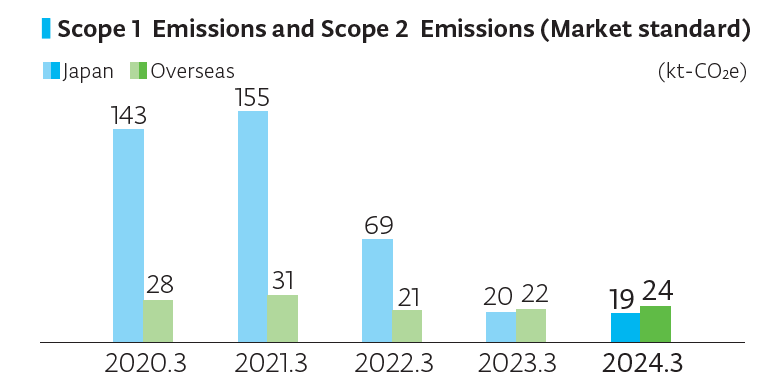
Water-Related Data
| FY2021 | FY2022 | FY2023 | FY2024 | FY2025 | ||
|---|---|---|---|---|---|---|
| Water | Water intake (thousandm³) | 1,397 | 1,417 | 1,495 | 1,542 | 1,587 |
| Japan | 1,183 | 1,204 | 1,255 | 1,293 | ●1,288 | |
| Groundwater | 430 | 440 | 402 | 373 | 394 | |
| Tap water | 450 | 479 | 520 | 569 | 579 | |
| Industrial water | 303 | 285 | 333 | 350 | 315 | |
| Overseas | 214 | 213 | 240 | 249 | 298 | |
| Water consumption (thousand m³) | 202 | 223 | 223 | 221 | 398 | |
| Japan | 177 | 195 | 193 | 196 | 362 | |
| Overseas | 25 | 28 | 30 | 24 | 36 | |
| Water discharge (thousand m³) | 1,195 | 1,194 | 1,272 | 1,321 | 1,188 | |
| Japan | 1,006 | 1,009 | 1,062 | 1,096 | 926 | |
| Overseas | 189 | 185 | 210 | 225 | 262 | |
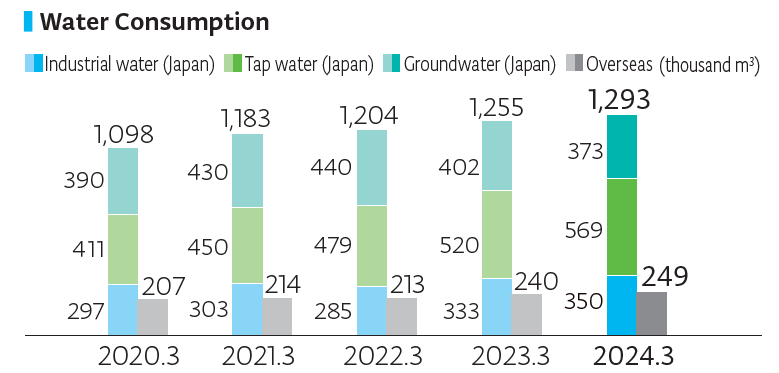
Energy Consumption/Generation
| FY2021 | FY2022 | FY2023 | FY2024 | FY2025 | ||
|---|---|---|---|---|---|---|
| Energy | Consumption metric (MWh*¹) (sales) (MWh/billion yen) | 2.99 | 2.19 | 2.10 | 2.71 | 2.21 |
| Consumption (MWh*¹) |
417,779 | 439,465 | 464,234 | 496,107 | 537,978 | |
| Japan | 344,582 | 362,852 | 379,750 | 402,788 | ●428,436 | |
| Overseas | 73,196 | 76,613 | 84,484 | 93,319 | 109,542 | |
| Electricity | Consumption (MWh) | 357,744 | 380,127 | 404,964 | 435,514 | 471,956 |
| Japan*³ | 297,435 | 316,017 | 333,572 | 353,428 | ●376,974 | |
| Overseas | 60,309 | 64,110 | 71,392 | 82,086 | 94,982 | |
| Gas (city gas, LPG) |
Consumption (MWh*¹) |
41,129 | 40,870 | 41,968 | 40,787 | 42,801 |
| Japan | 29,371 | 29,479 | 29,888 | 30,682 | ●33,053 | |
| Overseas | 11,757 | 11,391 | 12,080 | 10,105 | 9,748 | |
| Fuel (heavy oil A, diesel oil, kerosene, gasoline) | Consumption (MWh*¹) |
17,948 | 17,496 | 16,430 | 18,808 | 18,538 |
| Japan | 17,776 | 17,356 | 16,290 | 18,678 | ●18,409 | |
| Overseas | 172 | 140 | 140 | 130 | 129 | |
| Purchase of steam*² | Consumption (MWh) | 958 | 972 | 872 | 998 | 4,683 |
| Japan | 0 | 0 | 0 | 0 | 0 | |
| Overseas | 958 | 972 | 872 | 998 | 4,683 | |
| Renewable energy (electricity) | Purchase (MWh) | 4,980 | 227,523 | 365,876 | 393,383 | 419,512 |
| Japan | 0 | 197,137 | 330,791 | 353,428 | 376,974 | |
| Overseas | 4,980 | 30,386 | 35,085 | 39,955 | 42,538 | |
| PV power generation system | Power generation (MWh) | 4,068 | 3,890 | 4,110 | 3,901 | 3,820 |
| Japan | 4,068 | 3,890 | 4,110 | 3,901 | 3,802 | |
| Overseas | 0 | 0 | 0 | 0 | 18 | |
| Amount of self-consumption through onsite solar power generation system | Amount of self-consumption (MWh) | 2,783 | 2,695 | 2,780 | 2,837 | 2,677 |
| Japan | 2,783 | 2,695 | 2,780 | 2,837 | 2,659 | |
| Overseas | 0 | 0 | 0 | 0 | 18 | |
| Power sales | Power sales (MWh)*³ | 1,285 | 1,195 | 1,330 | 1,063 | 1,143 |
| Japan | 1,285 | 1,195 | 1,330 | 1,063 | 1,143 | |
| Overseas | 0 | 0 | 0 | 0 | 0 | |
| Renewable energy (electricity) use rate | Electricity use rate (%) | 2 | 60 | 91 | 90 | 89 |
| Japan | 1 | 63 | 100 | 100 | 100 | |
| Overseas | 8 | 47 | 49 | 49 | 45 | |
Changed to MWh notation
Added steam purchases overseas
Heat and steam not sold
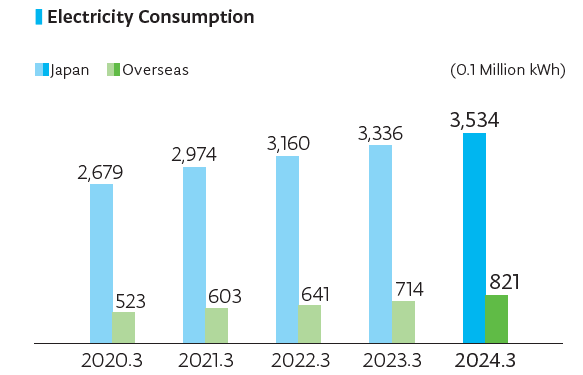
Environmental Impact of Logistics
| FY2021 | FY2022 | FY2023 | FY2024 | FY2025 | ||
|---|---|---|---|---|---|---|
| CO₂ | Emissions (kt-CO₂) | 89 | 136 | 139 | 76 | 151 |
| Japan | 9 | 15 | 19 | 12 | 16 | |
| Overseas | 80 | 121 | 120 | 64 | 135 | |
| Proportion of marine transportation (international) (%) |
34.3 | 33.2 | 39.0 | 42.1 | 50.1 | |
| Use of reinforced cardboard | Reduction in amount of wooden packaging materials used (t) Japan | ー | ー | 2,000 | 1,915 | 3,581 |
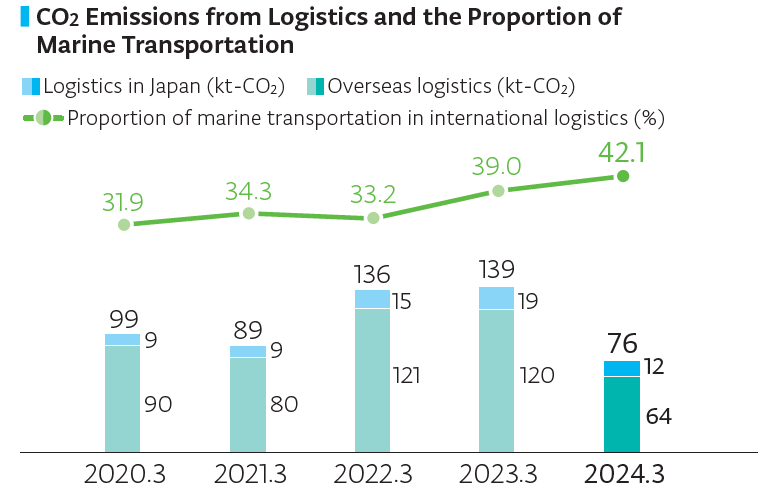
Amount of Waste Generated
| FY2021 | FY2022 | FY2023 | FY2024 | FY2025 | ||
|---|---|---|---|---|---|---|
| Waste | Amount generated (t) | 14,997 | 14,459 | 18,249 | 19,714 | 26,618 |
| Japan | 13,705 | 12,921 | 17,047 | 18,527 | 25,310 | |
| Overseas | 1,292 | 1,538 | 1,202 | 1,187 | 1,308 | |
| Recycling | Recycled amount (t) | 14,814 | 14,189 | 17,978 | 19,480 | 26,396 |
| Japan | 13,587 | 12,789 | 16,912 | 18,376 | 25,157 | |
| Overseas | 1,227 | 1,400 | 1,066 | 1,103 | 1,239 | |
| Incinerated and landfill waste | Amount of waste (t) | 183 | 270 | 271 | 234 | 222 |
| Japan | 118 | 132 | 135 | 151 | 153 | |
| Overseas | 65 | 138 | 136 | 84 | 69 | |
| Dangerous/Hazardous waste | Amount generated (t) | 7,227 | 5,231 | 5,634 | 7,743 | 10,664 |
| Japan (Specially controlled industrial waste) |
6,718 | 4,705 | 5,239 | 7,448 | ●10,371 | |
| Overseas (Dangerous/Hazardous waste per country) |
509 | 526 | 395 | 296 | 293 | |
| Dangerous/Hazardous waste recycling | Recycled amount (t) | 7,226 | 5,193 | 5,596 | 7,703 | 10,644 |
| Japan | 6,718 | 4,705 | 5,239 | 7,448 | 10,370 | |
| Overseas | 508 | 488 | 357 | 256 | 273 | |
| Dangerous/Hazardous waste incinerated/landfill disposal* | Amount of waste (t) | 1 | 38 | 38 | 40 | 21 |
| Japan | 0 | 0 | 0 | 0 | 0 | |
| Overseas | 1 | 38 | 38 | 40 | 20 | |
In fiscal year 2025, 2 tons were incinerated, and 19 tons were disposed of in landfills after being detoxified.
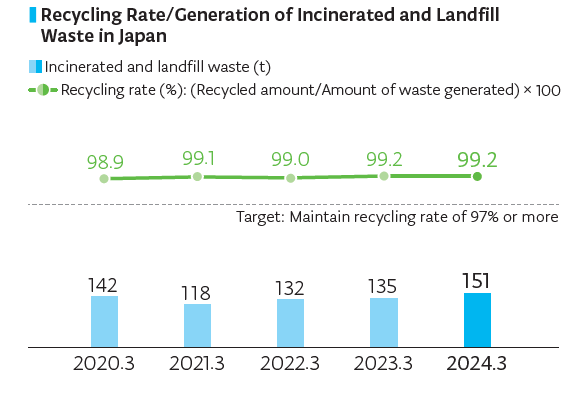
Chemical Substances Consumption/Emissions (Japan)
| FY2021 | FY2022 | FY2023 | FY2024 | FY2025 | ||
|---|---|---|---|---|---|---|
| PRTR Class I designated chemical substances*¹ | Volume handled (t) | 144 | 119 | 104 | 61 | 62 |
| Ferric chloride | 106 | 85 | 76 | — | ー | |
| Hydrogen fluoride and its water-soluble salts |
24 | 22 | 16 | 47 | 49 | |
| Methylnaphthalene | 13 | 11 | 10 | 11 | 10 | |
| Tetramethylammonium hydroxide | — | — | — | 2 | 1 | |
| VOCs*² | 0.1 | 0.1 | 0.1 | 0.2 | 0.2 | |
| Other | 1 | 1 | 1 | 1 | 1 | |
| Amount transported (waste amount) (t) |
131 | 108 | 94 | 48 | 50 | |
| Amount transported (sewerage) (t) |
0 | 0 | 0 | 2 | 2 | |
| Consumption (t) | 13 | 11 | 10 | 11 | 10 | |
| NOx | Emissions (t) | 13.0 | 13.1 | 12.7 | 12.9 | 14.8 |
| SOx | Emissions (t) | 4.9 | 4.8 | 4.5 | 4.6 | 4.5 |
Some substances have been added and others eliminated from the scope in accordance with the revision to target substances for fiscal year 2024.
VOCs: Volatile Organic Compounds
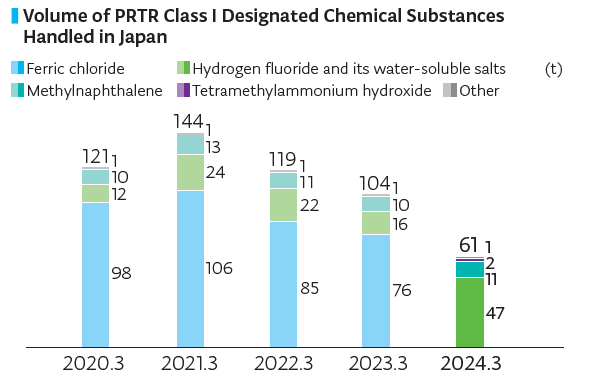
Other
| FY2021 | FY2022 | FY2023 | FY2024 | FY2025 | ||
|---|---|---|---|---|---|---|
| ISO 14001 | Number of certified offices | 11 | 11 | 11 | 11 | 11 |
| Japan | 5 | 5 | 5 | 5 | 5 | |
| Overseas | 6 | 6 | 6 | 6 | 6 | |
| Environmental investments | Environmental investment effects (millions of yen) | 32 | 30 | 31 | 16 | 9 |
| Environmental investment effects (t-CO₂) |
455 | 973 | 799 | 334 | 170 | |
| Biodiversity | Number of ecosystem tours* | 18 | 16 | 22 | 20 | 19 |
| Number of ecosystem tour participants* |
52 | 87 | 138 | 289 | 378 | |
| Environmental laws and regulations | Number of breaches of environmental laws and regulations | 0 | 0 | 0 | 0 | 0 |
| Amount of fines for breaches of laws and regulations | 0 | 0 | 0 | 0 | 0 | |
| Total product shipment (t)* | 28,862 | 41,352 | 48,922 | 35,769 | 46,946 | |
| Copier paper* | Use (t) (Japan) | 38 | 32 | 138 | 88 | 59 |
Scope: Japan
